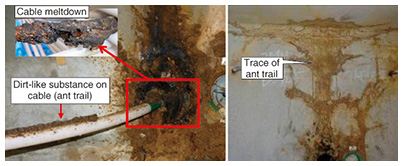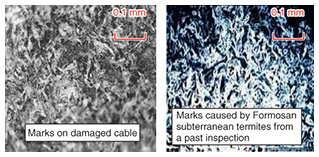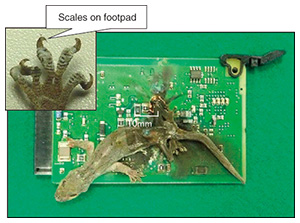 |
|
|
|
|
|
Practical Field Information about Telecommunication Technologies Vol. 12, No. 12, pp. 56–60, Dec. 2014. https://doi.org/10.53829/ntr201412pf1 Case Studies of Damage Caused by Wildlife in Access Network Facilities and CountermeasuresAbstractThis article introduces case studies of damage in access network facilities caused by wildlife, and also discusses countermeasures. This is the twenty-sixth of a bimonthly series on the theme of practical field information on telecommunication technologies. This month’s contribution is from the Access Engineering Group, Technical Assistance and Support Center, Maintenance and Service Operations Department, Network Business Headquarters, NTT EAST. Keywords: damage caused by wildlife, outdoor access network facilities, countermeasures 1. IntroductionNTT deploys access network facilities that support telecommunication services in every region of Japan. Most of these facilities are situated in outdoor environments, and malfunctions due to climate conditions such as wind, rain, snow, and lightning, and also those caused by animals living in the wild occur annually. Among the inspection requests made to the Technical Assistance and Support Center regarding access network facilities in fiscal years 2010–2012, 19% were related to damage caused by wildlife. This damage can be broken down into that caused by insects (e.g., black cicadas, ants, larvae of swift moths), rodents (e.g., squirrels, flying squirrels, rats, mice), and birds (e.g., crows, woodpeckers), as shown in Fig. 1 in descending order of prevalence. In short, these animals, which exist throughout Japan, are the cause of many malfunctions.
2. Types of damage and associated countermeasuresExamples of damage caused by birds include pecking of drop cables by crows and pecking of aerial cables by woodpeckers and other birds. Wrapping drop cables with PVC (polyvinyl chloride) cable protective covering is an effective means of preventing damage to cables caused by the pecking of crows, while upgrading aerial cables to high strength sheath (HS) cables that are resistant to damage from birds and other animals is an effective means of preventing the pecking of aerial cables by woodpeckers and other birds (Fig. 2). In addition, the latter problem, if restricted to a local area, can also be managed by applying anti-rodent sheets or anti-rodent tape (Fig. 3).
Damage caused by rodents includes gnawing of aerial cables and access boxes by squirrels and flying squirrels and gnawing of underground cables in manholes by rats and mice. The aforementioned HS cables and anti-rodent sheets and tape are effective in preventing the former type of damage, while commercially available protective coverings for access boxes are effective in preventing the latter type (Fig. 4). In addition, squirrels and flying squirrels climb on to aerial cables from the branches of trees, so cutting down trees in the immediate vicinity of those facilities is also an effective countermeasure. In fact, cutting down nearby trees should be the first idea studied when investigating possible countermeasures to aerial-cable damage. To prevent damage to underground cables, the paths that rats and mice use to penetrate the manhole need to be identified and closed off. It is also effective to close off the cable duct leading into the manhole by using a stopcock or other mechanism and to apply anti-rodent sheet or tape to exposed cables.
Damage caused by insects includes disconnections in drop cables caused by cicadas, disconnections in core fibers of optical fiber cables within closures caused by ants, and boring into aerial cables by larvae of swift moths. In the past, disconnections in drop cables by cicadas were essentially limited to western Japan, but they have recently begun to appear in eastern Japan as well. Replacing existing cables with cicada-resistant drop cables (V-notch cicada-proof drop cables) is an effective countermeasure. Meanwhile, ants can cause disconnections in the core fibers of optical fiber cables within closures because they can reach the fibers through gaps in the closure (Fig. 5). An effective countermeasure here is to eliminate such gaps by coating the interlocking parts of the closure with silicon sealant before closing the lid (Fig. 6). Finally, an effective means of dealing with the boring of aerial cables by larvae of swift moths is to upgrade the entire route with HS cables, and if the problem is localized, to apply anti-rodent sheets or tape. In addition, larvae of this type make their way onto aerial cables via trees and ivy, so cutting down and clearing nearby trees and ivy and/or installing ivy guards on stay wires that tend to become entangled in ivy are effective in cutting off the path of penetration.
The above countermeasures to damage caused by wildlife can be broadly divided into two categories: cutting off the penetration path and using protective products, regardless of the type of wildlife. 3. Case studies of damage caused by wildlifeThe previous section described the types of damage caused by different types of wildlife and the associated countermeasures, but here we introduce two key case studies of recent inspection requests made to the Technical Assistance and Support Center. 3.1 Case study of damage in submarine optical cable due to Formosan subterranean termitesIn this incident, a power-supply malfunction occurred in the repeater for a submarine optical cable, and a search for the fault found that there was a drop in insulation resistance in the copper tubing of the power-supply section near a manhole in the landing-station interval. An inspection request was issued to find the cause and determine a countermeasure. Inside the manhole, a dirt-like substance was found on top of the cable, and the outer sheath of the cable in the range 30–230 mm from the duct inlet was found to have melted (Fig. 7). As shown in the figure, the dirt-like substance on top of the cable forms an ant trail, which is characteristic of termites, consisting of a mixture of soil and dung. Moreover, a check on the state of the cable’s outer sheath revealed a number of marks, and an inspection using a digital microscope found that they had fluffy strings 0.01–0.02 mm in thickness (Fig. 8).
In this case study, the presence of an ant trail within the manhole, the similarity to damage in the cable’s outer sheath by Formosan subterranean termites confirmed in a past inspection, and the existence of a lumber yard near the manhole led to the conclusion that the damage here was also caused by Formosan subterranean termites. It was also inferred that the melting of the cable’s outer sheath occurred because the termite boring reached the copper tubing from the outer sheath and grounded the power-supply current. In Japan, Formosan subterranean termites are distributed along the Pacific coast of the Kanto region and west thereof, and since damage of this type can occur in manholes situated near rivers or coastlines, it is recommended that maintenance work and inspection on manholes in similar environments be accompanied by checks for ant trails, and that specialists be called in to exterminate and control such termites as needed. 3.2 Case study of damage in outdoor access network equipment due to gecko lizardIn this incident, a continuous ringing malfunction alarm (“RING” alarm) occurred in outdoor access network equipment (remote subscriber module F (RSBM-F)), and an initial inspection revealed a line card with the burnt carcass of a gecko lizard. An inspection request was therefore issued to find the path by which the gecko entered the RSBM equipment and to determine a countermeasure. The gecko that was stuck on the line card was assumed to be of the Japanese gecko type because of its distinguishing features such as its length and the scales on its footpads (underside of toes) (Fig. 9). The RSBM-F equipment that the gecko penetrated was surrounded by a lush growth of trees and plants. A search for the penetration path revealed that minute crevices in the cabinet door, MDF (main distribution frame) door, and cable inlet could not have served as a penetration path for the gecko. However, it is known that geckos prefer to inhabit crevices and other tight spaces, so it was inferred that the gecko must have entered the equipment while the RSBM-F door was being opened or closed. It is therefore recommended that trees and plants in the vicinity of RSBM-F equipment that can serve as a habitat of geckos and insects be periodically cleared, that a check be made beforehand for the presence of wildlife in door crevices when opening or closing doors, and that any wildlife present be removed.
4. ConclusionThis article explained typical methods for preventing damage caused by wildlife in access network facilities and presented two case studies in which such damage occurred and described how the situations were dealt with. Although it is difficult to completely prevent all facility damage caused by wildlife, it is hoped that the countermeasures and case studies presented here will be useful in at least reducing the scope of this damage. The Technical Assistance and Support Center has been involved for more than 50 years in technical assistance and support activities if we include its predecessor, the Technical Assistance and Support Department. Going forward, we are committed to leveraging the knowledge and experience gained to date to further improve the reliability of telecommunication facilities and reduce the number of problems that occur in the field. |
|

















